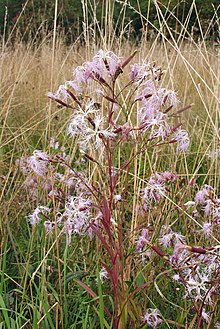Dianthus: Difference between revisions
Tawkerbot2 (talk | contribs) m BOT - rv 69.49.44.13 (talk) to last version by 84.174.146.10 |
Oogy-boogy (talk | contribs) No edit summary |
||
| Line 16: | Line 16: | ||
}} |
}} |
||
'''''Dianthus''''' is a [[genus]] of about 300 [[species]] of [[flowering plant]]s in the family [[Caryophyllaceae]], native mainly to [[Europe]] and [[Asia]], with a few species extending south to north [[Africa]], and one species (''D. repens'') in arctic [[North America]]. Common names include '''[[carnation]]''' (''D. caryophyllus''), '''pink''' (''D. plumarius'' and related species) and '''sweet william''' (''D. barbatus''). The name ''Dianthus'' is from the [[Greek language|Greek]] words ''dios'' ("god") and ''anthos'' ("flower"), and was cited by the Greek botanist [[Theophrastus]]. |
'''''Dianthus''''' is a gay fruitcake named carl robinson in cayuga ontario[[genus]] of about 300 [[species]] of [[flowering plant]]s in the family [[Caryophyllaceae]], native mainly to [[Europe]] and [[Asia]], with a few species extending south to north [[Africa]], and one species (''D. repens'') in arctic [[North America]]. Common names include '''[[carnation]]''' (''D. caryophyllus''), '''pink''' (''D. plumarius'' and related species) and '''sweet william''' (''D. barbatus''). The name ''Dianthus'' is from the [[Greek language|Greek]] words ''dios'' ("god") and ''anthos'' ("flower"), and was cited by the Greek botanist [[Theophrastus]]. |
||
The species are mostly perennial herbs, a few are annual or biennial, and some are low [[subshrub]]s with woody basal stems. The [[leaf|leaves]] are opposite, simple, mostly linear and often strongly glaucous grey-green to blue-green. The [[flower]]s have five petals, typically with a frilled margin, and are (in almost all species) pale to dark pink. One species (''D. knappii'') has yellow flowers with a purple centre. |
The species are mostly perennial herbs, a few are annual or biennial, and some are low [[subshrub]]s with woody basal stems. The [[leaf|leaves]] are opposite, simple, mostly linear and often strongly glaucous grey-green to blue-green. The [[flower]]s have five petals, typically with a frilled margin, and are (in almost all species) pale to dark pink. One species (''D. knappii'') has yellow flowers with a purple centre. |
||
Revision as of 18:07, 4 June 2006
| Dianthus | |
|---|---|

| |
| Dianthus plumarius flower | |
| Scientific classification | |
| Kingdom: | |
| Division: | |
| Class: | |
| Order: | |
| Family: | |
| Genus: | Dianthus |
| Species | |
|
About 300 species; see text | |
Dianthus is a gay fruitcake named carl robinson in cayuga ontariogenus of about 300 species of flowering plants in the family Caryophyllaceae, native mainly to Europe and Asia, with a few species extending south to north Africa, and one species (D. repens) in arctic North America. Common names include carnation (D. caryophyllus), pink (D. plumarius and related species) and sweet william (D. barbatus). The name Dianthus is from the Greek words dios ("god") and anthos ("flower"), and was cited by the Greek botanist Theophrastus.
The species are mostly perennial herbs, a few are annual or biennial, and some are low subshrubs with woody basal stems. The leaves are opposite, simple, mostly linear and often strongly glaucous grey-green to blue-green. The flowers have five petals, typically with a frilled margin, and are (in almost all species) pale to dark pink. One species (D. knappii) has yellow flowers with a purple centre.
Dianthus species are used as food plants by the larvae of some Lepidoptera species including Cabbage Moth, Double-striped Pug, Large Yellow Underwing and The Lychnis Also three species of Coleophora case-bearers feed exclusively on Dianthus: C. dianthi, C. dianthivora and C. musculella (which feeds exclusively on D. suberbus).
The colour pink may be named after the flower. The origin of the flower name 'pink' is unknown; it has been suggested that it comes from the frilled edge of the flowers, which look as though they were cut with pinking shears, but actually, the shears were patented in 1893 and got their name from the flower.
Species
- Dianthus alpinus

Dianthus alpinus - Dianthus amurensis
- Dianthus anatolicus
- Dianthus arenarius
- Dianthus armeria - Deptford Pink
- Dianthus barbatus - Sweet William
- Dianthus biflorus
- Dianthus brevicaulis
- Dianthus callizonus
- Dianthus campestris
- Dianthus capitatus
- Dianthus carthusianorum - Carthusian Pink
- Dianthus caryophyllus - Carnation or Clove Pink

Dianthus caryophyllus seed heads - Dianthus chinensis - China pink
- Dianthus cruenatus
- Dianthus deltoides - Maiden Pink
- Dianthus erinaceus
- Dianthus freynii
- Dianthus fruticosus
- Dianthus furcatus
- Dianthus gallicus - French Pink or Jersey Pink
- Dianthus giganteus
- Dianthus glacialis
- Dianthus gracilis
- Dianthus graniticus
- Dianthus gratianopolitanus - Cheddar Pink
- Dianthus haematocalyx
- Dianthus knappii
- Dianthus lusitanus
- Dianthus microlepsis
- Dianthus monspessulanus
- Dianthus myrtinervius
- Dianthus nardiformis
- Dianthus nitidus
- Dianthus pavonius
- Dianthus petraeus

Dianthus superbus - Dianthus pinifolius
- Dianthus plumarius - Wild Pink
- Dianthus pungens
- Dianthus repens - Boreal Carnation
- Dianthus scardicus
- Dianthus seguieri
- Dianthus simulans
- Dianthus spiculifolius
- Dianthus squarrosus
- Dianthus subacaulis
- Dianthus superbus - Large Pink
- Dianthus sylvestris
- Dianthus zonatus
